Text
i don’t know why but i’m really amused by the winner of some ‘new kanji’ contest:

compare with the real kanji

座 (seat/gathering), but the two 人 (person) radicals have been moved from next to each other within the 土 (earth) radical to diagonally from each other, making this “social distance(d seating/gathering)”
92K notes
·
View notes
Text
That comes in handy just when I have to submit the first chapter in few weeks! (I'm writing on Machine Learning in Text Classification.)
A paper-writing tip from my thesis director:

Every time you are reading materials and you come across an important concept, write it down in flashcard. Give the concept a title, write who said it, and where to find it later (this is also a good way of practicing citation).
Once you have a lot of your materials read you can spread them all throughout your room like a crazy person (which feels amazing) and start creating your own narrative, organizing it in your own unique way. This way, you might even land on a new concept!
Tell me about the paper you're writing! These flashcards are for a paper on Retributivist Punishment Theory (Criminal Law) 💫
22 notes
·
View notes
Photo

This isn’t just advice for uni students, but for anybody, I’ve just decided to tackle us uni students in general, because our days are not as structured anymore and with our lectures here at 11AM on one day and at 3PM on the other, it’s very hard to keep each and every day the same. Generally, though, this can be used for anybody who’s looking for some structure in their life.
Why?
Because it gives you an idea of what you are spending your time on. With a solid and good schedule, there should be less time for procrastination. Besides that, a sense of control gives many people comfort, especially people who struggle mentally.
Where to start:
Write down your schedule. Work, weekly appointments, lectures, classes. All those things that are ‘set in stone’ and that you cannot control. This is going to be the base you build around. I suggest making a table, preferably on a piece of paper (you can transfer it into a digital version when you’re done and have everything figured out) with all days of the week and hours. I personally used 7AM – 11PM.
Set your wake up and bed times. The most important ones. You should make these all the same. Maybe give yourself an extra hour of a lie in on Saturday and Sunday, but you should try and not confuse your biological clock too much. Soon, it will become easier to get up early. Also make sure you are getting enough hours of sleep. As a young adult of around 20, you should be getting 6-9 hours of sleep. If you are younger, it should be more than that.
Write up your daily tasks that you would like to perform every day. Make sure you include all those things you keep forgetting, self-care items, daily reading, journal writing, studying, etc. Be realistic, however. Start out small with just a few things, don’t overwhelm yourself and later, you can start adding more items.
Then do the same for weekly tasks. These include doing readings for particular classes, clean ups, exercise, meet-ups, etc.
Don’t forget meals! Especially if you are busy, make sure there is room for food in your plan! Make sure that if you have an especially full day the next day, think of some time to prepare the food the night before. Planning out your meals may also make you think about what you eat more. (Also, I can write something about nutrition on request!)
Don’t forget free time either. Free time is important and a free day is something you could benefit from. Whether it is resting or catching up on your studies or time for arts and crafts.
Now play a nice game of Tetris and assign a time slot to each of those activities. Don’t forget to just leave some time off. Whether that’s for finishing a task, being lazy or just anything. Use your routine to give your life a structure, not govern it completely.
How to implement these and make sure they work?
There are for sure going to be some you struggle with. Set phone alarms. Set them for every five minutes. Set them until they annoy you. Until it’s so annoying it makes you do the task you don’t want to do.
I followed these steps to make my own routine for my new semester and I had something similar, but not as elaborate last semester. The one for this semester isn’t done yet since I still need one additional module and my fixed working times. But after that, I may post my routine on here and then some follow ups as well, just to see how well it’s going. Same goes for you, tag me (ravenclawhard) if you are going to use these tips. I’d love to know!
8K notes
·
View notes
Photo
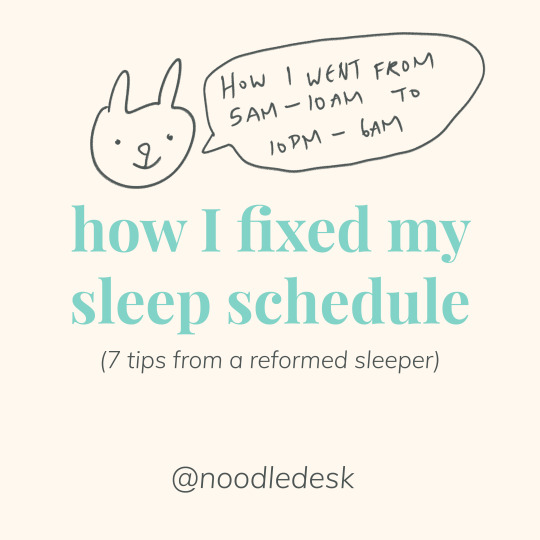


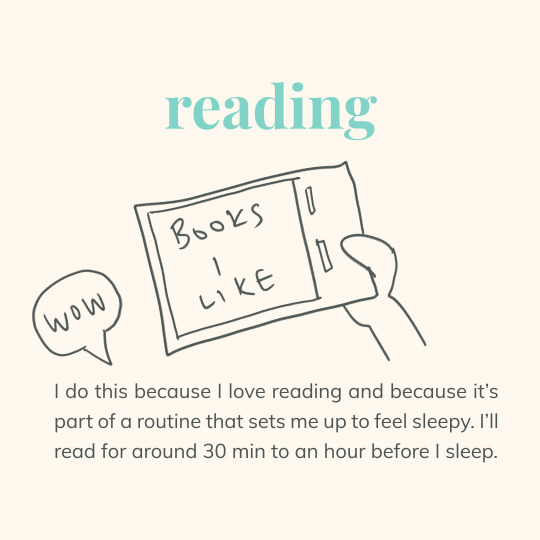

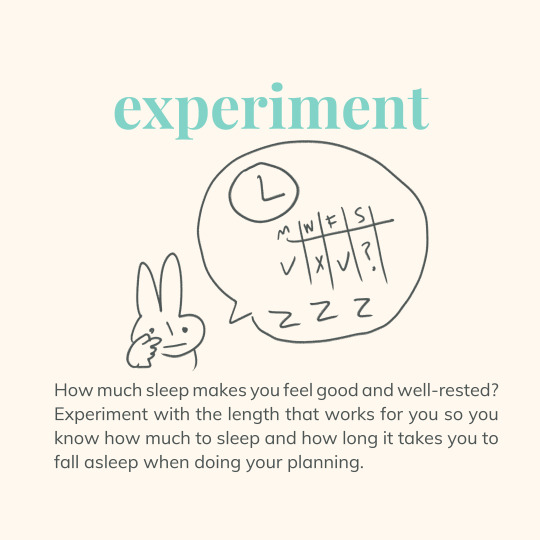


last year i used to sleep from 5 am to 10 am every day and it was Not Good for me. i’ve gotten a couple of questions about my sleep schedule so i thought i’d share some tips that helped me adopt a healthier sleep schedule. enjoy 🛏💤
11K notes
·
View notes
Text
That’s very nice! I’m using Trello in a group engineering project and we have a similar system, but instead of Blocked we have Ready + In Review for when someone has to check it out first before calling it Done.
Great idea with the labels, it’s surely a better system! (And how did you do these little patterns? :D)
Dev Log 2: Setting up Trello
I’ve used trello a couple of times in the past and I really liked it so I decided to use it for this too. I looked at a bunch of templates that could help me manage a project like this. I settled on a modified version of the project management template with labels I saw in another template (I can’t remember which one). Here’s how I set it up:
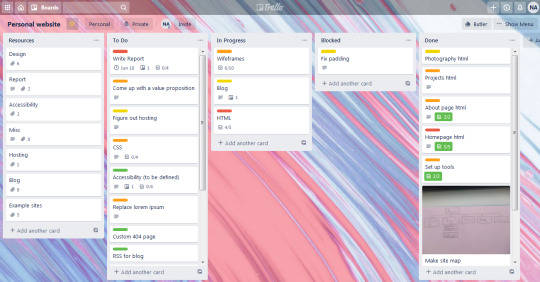
I have 5 lists:
Resources
To Do
In Progress
Blocked and
Done
I group the resources I need (tutorials, guides, instructions, references etc) into cards. That way I can link the resources card to the relevant task card. Some resources might be useful in multiple cards so instead of having to copy the same links into each card I just have to link one card for easy access. To Do, In progress and Done are pretty self explanatory. Blocked is for tasks that are almost done, but for some reason can’t be finished right now. It could be because they’re waiting on something else to be done, or I’m waiting for some feedback from friends etc.
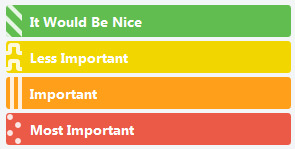
The labels I’m using are:
It Would be Nice
Less Important
Important and
Most Important
I’ve previously used high, medium and low priority and had a very hard time assigning them, but with this new system it’s much easier for me. (Words matter, who knew ¯\_(ツ)_/¯ )
It took a while to fill it out with tasks and I’m still adding things or breaking tasks down into smaller ones, but I love it. I love the flexibility.
17 notes
·
View notes
Photo






042420
As most people are working and studying from home right now, I wanted to share some concrete, implementable ways you can help yourself feel better. Though I believe productivity and quantity of work done (or lack thereof) doesn’t/shouldn’t translate into your self-worth and how you view yourself, when you get work done, you actually do feel better in your own body.
By the way, it’s the first time I’m formatting a tips/guide post like this, so I apologize that I couldn’t be more concise.
I’ve spoken to a licensed professional counsellor as well as to some professionals who have been working from home for a long time, and some of the advice above is from them. I’m also sharing from my own experience as someone who used to be very productive and an (ex-)overachiever, and still attach a lot of my self-worth to grades and other tangible accomplishments. I hope these slides can help you. In case it’s hard to read, I’ve included it (reworded) in text form if you’d like to read more.
Keep reading
15K notes
·
View notes
Text
Mutual Intelligibility Resource Guides for teaching or self-teaching the International Phonetic Alphabet
We’ve made two guides to the teaching resources available for the International Phonetic Alphabet as part of the Mutual Intelligibility project.
IPA Charts
Interactive IPA Chart
A free, web-based IPA chart. Each symbol is clickable and plays the corresponding phoneme. Good for an introduction to IPA or phonology in general.
IPA Lab Audio Illustrations
A far more detailed and complete IPA chart showing more phonemes and diacritics with detailed descriptions at the bottom of the screen for each symbol you click on. This would be good for a more complete and technical look at phonology and the IPA.
OSU Interactive IPA Chart
6 separate interactive IPA charts for specific phonemes found in these major world languages: Chinese, English, Indian, Korean, Spanish, Turkish.
rtMRI IPA charts
Each clickable phoneme or word corresponds to an MRI of someone’s oral and nasal cavities while they say that phoneme/word.
Introduction to IPA Consonants
The Art of Language Invention, Episode 21: Ejectives and Implosives
A short explanation and demonstration of implosive consonants. May be of interest to English-speaking students who have rarely, if ever, heard these before. Length: 7m32s total; timestamped at implosive section - section 4m40s. Captions: auto.
Vox: Why some Asian accents swap Ls and Rs in English
A less technical but professional, detailed look at a common question about speakers of Mandarin, Cantonese, Japanese, and Korean who learn English as a second language. Includes an interview with Eleanor Lawson about using ultrasound to study phonology. Length: 8m56s. Captions: human-edited.
NativLang: Weird Phonemes - pronouncing the world’s rarest sounds
A short animated crash course in phonemes (almost all consonants) that English speakers are likely unfamiliar with. Length: 5m54s. Captions: human-edited.
Podcast: Lingthusiasm Episode 6: All the sounds in all the languages - The International Phonetic Alphabet
Section: Origin of the IPA symbols (9:16-11:50)
Section: Format of the IPA consonant table and mouth position (16:18-19:45)
Making Flaps Vibrate In Your Throat: Voicing
This Tom Scott video is an explanation of voicing only, but it’s short and very engaging. Length: 3m18s. Captions: human-edited.
The Language Sounds That Could Exist, But Don’t
This Tom Scott video is a nice introduction to the IPA chart as a whole and the grey “articulations judged impossible” area. Length: 6m30s. Captions: human-edited.
Introduction to IPA Vowels
ArticulatoryIPA YouTube Playlist
A collection of animations and ultrasounds that depict people pronouncing various phonemes. Captions: we’re not exactly sure how one would caption this.
Essential of Linguistics: 2.8 Diphthongs
A short technical video about diphthongs with mini-quiz below; dry but informative. Length: 3m00s. Captions: human-edited.
Aaron Alon: What If English Were Phonetically Consistent?
A fun look at the relationship of English spelling to its phonology, mostly focused on the (in)consistency of our vowels. Breaks each vowel grapheme down into the different IPA symbols it’s likely to represent in English. Length: 4m05s. Captions: auto.
NativLang: Intro to Phonology: Consonants & Vowels
A short animated explanation of phonology in general. Length: 3m30s. Captions: human-edited.
Tech Tips
TypeIt: IPA Phonetic Symbols
An easy-to-use website that lets you easily type IPA symbols (either full IPA or language-specific subsets) into a text box, which you can then copy-paste elsewhere as needed.
How to Type the IPA on your phone (iOS or Android)
Several good free IPA phone keyboard options, reviewed.
Read the full consonants guide or vowels guide, or subscribe to the newsletter for all teaching resource compilations.
363 notes
·
View notes
Text

26•01•2020
This studyblr may be dead but there's nothing like Sunday's night study session.
5 notes
·
View notes
Text
Languages of Europe
Polish (język polski)
Basic facts
Number of native speakers: 40 million
Official language: Poland, European Union (EU)
Minority language: Czech Republic, Romania, Slovakia, Ukraine
Language of diaspora: Australia, Argentina, Austria, Brazil, Canada, France, Germany, Ireland, New Zealand, United Kingdom, United States
Alphabet: Latin, 32 letters
Grammatical cases: 7
Linguistic typology: inflectional, pro-drop, SVO
Language family: Indo-European, Balto-Slavic
Number of dialects: 8
Longest word: konstantynopolitańczykowianeczkówna (unmarried daughter of an inhabitant of Constantinople) - 36 letters
History
10th century - Polish began to emerge as a distinct language
1270 - earliest known sentence written in Polish
1500-1700 - Polish was a lingua franca in Central Europe
The oldest known example of written Polish is a single sentence attributed to a Czech speaking to his Polish wife recorded by a German monk in an otherwise all Latin text, the history of a Cistercian abbey in the Lower Silesian region.
Writing system and pronunciation
These are the letters that make up the alphabet: a ą b c ć d e ę f g h i j k l ł m n ń o ó p q r s ś t u v w x y z ź ż.
There are four diacritics: tail (ą, ę), acute accent (ć, ń, ó, ś, ź), bar (ł) and dot (ż).
Of particular interest in the Polish sound system is the contrast between two groups of sounds that seem to be identical to non-Poles. For example, the letter combination sz and ś both sound similar to English ‘sh’. The difference is that sz is a palatal retroflex while ś is an alveo-palatal.
Grammar
Polish has a very rich system of prefixes and suffixes, and the latter often cause changes to both consonants and vowels.
The number of genders in Polish has been and continues to be a matter of debate. There are three or four genders in the singular and two in the plural. The reasons for this are that the traditional masculine gender seems to be breaking up into two separate genders: animate and inanimate. There are seven cases (nominative, genitive, dative, accusative, instrumental, locative, vocative).
Adjectives agree with nouns in terms of gender, case and number. Attributive adjectives most commonly precede the noun, although in certain cases, the noun may come first.
Verbs are of imperfective or perfective aspect, often occurring in pairs. Imperfective verbs have a present tense, past tense, compound future tense, subjunctive/conditional, imperatives, an infinitive, present participle, present gerund and past participle. Perfective verbs have a simple future tense, past tense, subjunctive/conditional, imperatives, infinitive, present gerund and past participle.
Dialects
Polish dialects include Greater Polish (wielkopolski), spoken in the west; Lesser Polish (małopolski), spoken in the south and southeast; Masovian (mazowiecki), spoken throughout the central and eastern parts; Silesian (śląski), spoken in the southwest; Kashubian (kaszubski), spoken west of Gdańsk; Goral (góralski), spoken along the border between Poland, Czech Republic and Slovakia; Poznanski, spoken in Poznań, and the Eastern Borderlands dialect (kresy), spoken in the northeast and by Poles living in Lithuania and Belarus.
Silesian and Kashubian are considered to be separate languages by some people.
173 notes
·
View notes
Text
what to do when everything’s a mess
Wash your hair. Don’t worry about all those articles online about the best haircare products of 2019 and whatnot, get in, wash it like you usually do, get out. Leave it to air dry, it’s less work for you.
Brush your teeth. Even if you brushed them this morning and are probably going to brush it tonight, do it anyway. Especially if it’s exam time, all that tea or coffee you’re most likely downing (props to you if you only study with water) probably makes them feel kind of gross.
I know most of these lists tell you to run a bath, but let’s face it, for those of you who even have a bath in the first place, the thought of filling that tub and sitting there in complete silence for a couple hours seems like a trek. And ironically exhausting. So instead, just brush your hair, take a nap (set a nice soothing alarm) and once you’ve gotten out of bed, wash your face or at least splash cold water on your face.
CLEAN clean clean clean CLEAN. Easier said than done, but at least start by clearing one messy component of your area; it could be your floor, your desk or your bed. You don’t need to clean and re-organise your entire room marie condo-style for you to actually have a reason to take the time to clean in the first place. A little goes a long way, and you don’t ALWAYS need to do the hard yards ya know.
I would say read a book, but sometimes your brain is melting or buzzing so it can’t really focus on anything lengthy. So instead, find someone reciting a poem online, and just listen to it. I recommend Jeremy Irons and his voicing of tons of T.S Eliot poetry, or Allen Ginsberg reciting his own poetry (Howl is a classic).
If you’re one of those people who drowns their sorrows by listening to music, don’t listen to music!! Don’t reinforce your pain!! So to that I say, listen to a podcast. If the classic podcast genre of true crime is a little too stressful and you’ve already cried twice today, listen to interviews with actors, screenwriters and directors. It can be really refreshing to listen to people you already enjoy the content of talk about their work. I recommend Awards Chatter and Happy Sad Confused.
Stop staring at screens! Just physically sit outside for a bit, you don’t need to go for a jog or do a general workout, just…sit. People-watch, try and memorise the exact scene in front of you, from the mis-en-scene to all the colours and sounds and the way the sunlight feels on your eyelashes. Write it down if you want to, you could even denote a single notebook to your little outdoor descriptions. Or just write on a napkin. To each their own.
Have you eaten today? And I mean something hearty, something that isn’t primarily made out of air and salt. Something that falls under the umbrella of snack does not count; meal is more like it. If not, eat. Preparing food might feel exhausting, but so’s going a relatively long amount of time without something nutritionally substantial.
If you’re feeling emotionally heavily, get out a notebook or even just a scrap of paper, a pen and cry until your eyes are as blurry as can be. With tears down your cheeks, scribble out how you’re feeling. Don’t bother with how neat or messy it is, whether the sentences even stay on the lines, it’s not about being aesthetic. In fact, it’s about being as messy as possible. Let all of it out, and let is act as a physical manifestation of what’s going on in your head. Don’t fight it or deny it, relieve yourself by both constructing and understanding yourself.
33K notes
·
View notes
Text
Polish words for noun and verb are literally “thinger” and “timer”. Pretty self-explanatory.
something i really like about japanese linguistics is the direct translation the parts of speech have with their purpose:
for example: adjectives are 形容詞 (keiyoushi) which literally breaks down into”form 形 +contain/appearance 容 +part of speech/word 詞 ” or more concisely “modifying 形容 + part of speech 詞”
adverbs are 副詞 (fukushi) which is literally the “vice/assistant + part of speech” as the 2nd in command to verbs
verbs are predictable, even before confirming the definition of the kanji i knew it would directly mention movement. 動詞 (doushi) = “motion + part of speech”
19 notes
·
View notes
Text
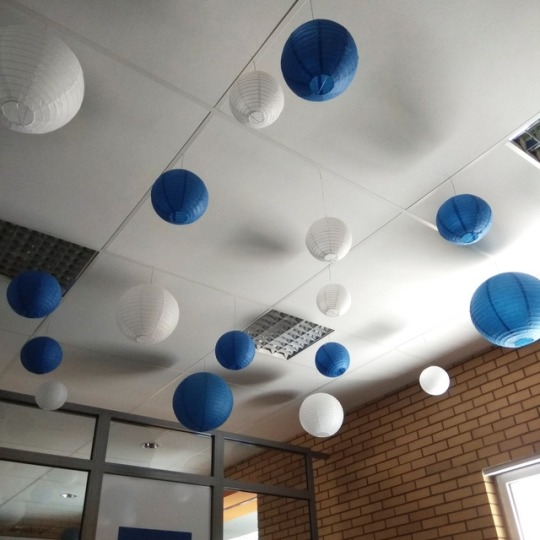

“I don't know if you heard, in one hour and a half I'm going to ask you what you've learnt. Have fun!”
So I'm now cramming automata theory in my faculty chill out zone. (It's totally empty for once!)
4 notes
·
View notes
Text
People don’t hate math. They hate being confused, intimidated, and embarrassed by math. Their problem is with how it’s taught.
184K notes
·
View notes
Text

06•03•2019
I had a library tour recently. From top to bottom:
Introduction to linguistics
Grammar of Polish language
Numerical methods
Shell scripts
As you can see, I'm quite flexible, lol. No clue when I will find time for it.
2 notes
·
View notes
Text
Ah yes, big news
05•03•2019
I got accepted as an intern in natural language processing research project. They said I got it because of my interest in linguistics and some text processing skills. Woohoo!
6 notes
·
View notes
Text

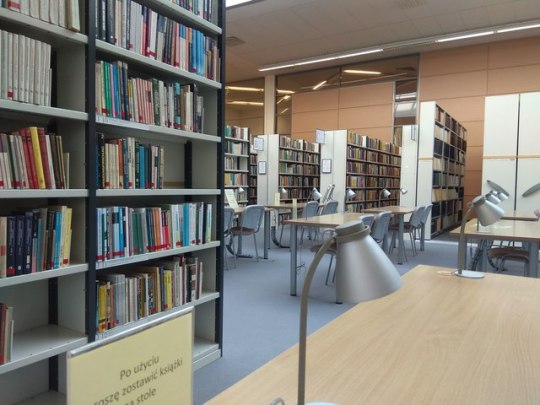
28•02•2019
Note making at the library.
5 notes
·
View notes
Text
Today is International Mother Language Day
Today is a day to celebrate our native languages. Today is a day to fight the oppression based upon language. Today is a day to honour those who have fallen due to their struggle to speak their mother tongue.
On February 21, 1952, students in Dhaka, Bangladesh, protested against oppression of the Bengali Language. Those students were massacred by the ruling Pakistani police. In honour of that blood-smeared day, we move to encourage linguistic diversity and awareness of linguistic traditions.
1K notes
·
View notes